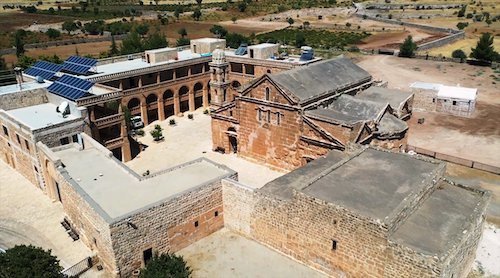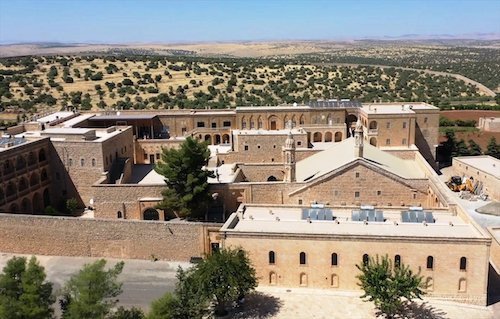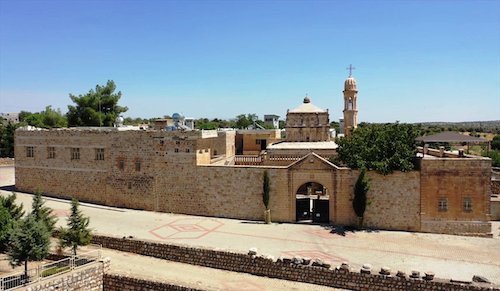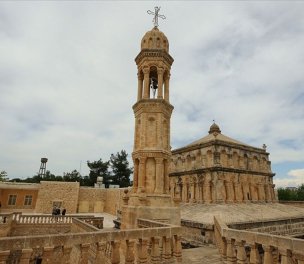Photos: AA
Click to read the article in Turkish
The Ministry of Culture and Tourism has announced that several late Antique Age and Medieval monasteries and churches in Mardin's Tur Abdin area have been included in the tentative list of UNESCO World Heritage.
Tur Abdin, a hilly region mostly occupied by Syriac Christians until the last century, is located in the Midyat district. The region is bounded by the River Tigris in the north and east, by the Mesopotamian plain in the south, and by the modern city of Mardin in the west.

The rural landscape covers eighty villages with approximately one hundred churches and seventy monasteries.
The antiquities included in the list are Mor Sobo Church, Mother Mary Church (Yoldath Aloho), Deyrulzafaran Monastery, Mor Gabriel Monastery, Mor Abai Monastery, Mor Lozoor Monastery, Mor Yakup Monastery, Mur Quryaqos Church and Mor Azozo Church.

Midyat District Mayor Veysi Şahin told the state-run Anadolu Agency (AA) that they believe the addition to the UNESCO list will lead to an influx of tourists. "We need to develop culture and religious tourism for the development and prosperity of the region," he said.
Mor Yakup Monastery Priest Edip Daniyel Savcı emphasized the importance of monasteries and churches for religious officials. "It's a good thing that such places are taken under protection. This is what we want," he told the Mesopotamia Agency (MA).

Habib Doğan, the mukhtar of Anıtlı village who also works at Mother Mary Church, told MA that it was a pleasing decision. "I believe that all Syriacs will welcome this with great joy. It's really important for all of us. I hope it will be on the permanent list in the future. We would like to thank everyone who contributed."
About Tur AbdinMidyat is located in the center of Tur ʿAbdin (meaning "the Mountain of the servants of God" in Syriac) region, a limestone plateau in south-eastern Turkey. The region is bounded by the River Tigris in the north and east, by the Mesopotamian plain in the south, and by the modern city of Mardin in the west. Stretching around 120 km. In east-west and 50 km, in north- south direction, the rural landscape covers eighty villages with approximately one hundred churches and seventy monasteries. This rural religious architecture belongs to the Syriac Orthodox community and its history goes back to the period when the region was under the Byzantine rule. Despite being within the boundaries of Muslim states since the 7th century, Tur ʿAbdin was populated mostly by Syriac Christians until the last century. Tur ʿAbdin has been settled from the Assyrian period onwards. However, it was in the 6th century that it became a holy mountain for the Syriac Orthodox who had to live a life in exile due to Christological disputes resulting from the Council of Chalcedon in AD 451. The Syriac Orthodox Church, which was miaphyiste, was considered to be heretic by the imperial church of the Byzantine Empire. As a result, the Syriac Orthodox developed a rural church hierarchy and they started to build churches and monasteries in the rural Tur ʿAbdin which was a secluded region. Depending on the position of the Emperor's stand on the miaphysite dispute, some of these monasteries benefited from the imperial patronage, such as the benefaction of the Emperor Anastasius (d. 518) to the monastery of Mor Gabriel. With its remarkable architectural sculpture, the monastery of Deyrul Zafaran also indicates imperial patronage. After the Arab conquest of the region in 640, the Syriac Orthodox continued to build churches and monasteries. In fact, it has been argued that they experienced a sense of freedom for some time as they were considered as heretic by the Byzantines. Especially in the first two centuries of the Arab rule, we find a flourishment in the building of churches and monasteries in the region. The most remarkable aspect of these churches and monasteries is that they present continuity. Monastic churches were continued to be built as transverse-hall type churches. The village churches took the example of Mor Sobo and built as hall-type churches. There was a tradition of classical sculpture in the region in the 6th century in the region, even if it was abandoned in Constantinople. A stylized version of this sculpture was seen in the 8th century churches. The 12th century is known as "Syriac Renaissance" in terms of literary production. In Tur ʿAbdin, John, the bishop of Mardin, is known to have built many churches and monasteries then. 12th century parts of the monastery of Mor Abai testify to this flourishment and relations between Artuqid rulers and Syriac community with its inscriptions. In these churches and monasteries, the liturgy is practiced in ancient Syriac which is the Edessan dialect of Aramaic and is considered to be a bridge language in the translation movements from Greek to Arabic. Today, a neo-Aramaic dialect of Syriac, called Turoyo is still spoken in the region and it is enlisted as a severely endangered language in UNESCO Atlas of the World's Languages in Danger. Source: UNESCO |
(TP/VK)




.jpg)

